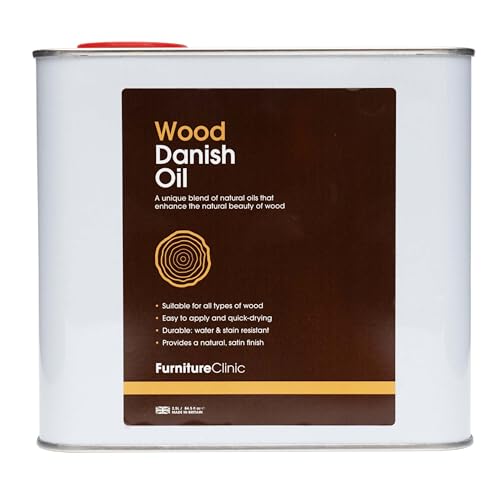




Wooden worktops are a popular choice for many homeowners due to their natural and warm appearance. However, it is important to take proper care of these surfaces to ensure their longevity and maintain their beauty. Cleaning wooden worktops requires a gentle touch and the use of appropriate cleaning methods to avoid damaging the wood.
Firstly, it is essential to regularly wipe down your wooden worktop with a damp cloth to remove any spills or stains. However, avoid using excessive water, as this can penetrate the wood and cause warping or discoloration over time. Instead, dampen a cloth with warm water and gently wipe the surface, ensuring to dry it thoroughly afterwards to prevent any moisture from being absorbed.
In addition to regular wiping, it is recommended to use a mild cleaning solution specifically designed for wooden surfaces. These solutions are typically formulated to remove dirt and grime without causing any harm to the wood. When using a cleaning solution, apply it to a cloth or sponge rather than directly onto the worktop, and gently rub the surface in circular motions. Afterwards, rinse the cloth or sponge and wipe down the worktop to remove any residue.
For tougher stains or built-up grime, you may need to use a slightly more abrasive approach. In this case, you can create a homemade cleaning paste by mixing baking soda with water to form a thick paste. Apply this paste to the stained area and gently scrub with a soft brush or sponge. Be sure to rinse the worktop thoroughly after cleaning to remove any residue from the paste.
By following these cleaning tips and methods, you can keep your wooden worktops looking their best and extend their lifespan. Remember to always handle these surfaces with care and avoid using harsh chemicals or abrasive materials that can cause damage. With regular maintenance, your wooden worktops will continue to enhance the beauty of your kitchen for years to come.
Note: Always refer to the manufacturer’s instructions for specific cleaning recommendations for your wooden worktops.
Tips for Cleaning Wooden Worktops
Wooden worktops can add a touch of warmth and beauty to any kitchen. To keep them looking their best, it’s important to clean them regularly and properly. Here are some tips to help you effectively clean your wooden worktops:
1. Use the Right Cleaning Products
When it comes to cleaning wooden worktops, it’s important to avoid harsh chemicals or abrasive cleaners. These can damage the wood and strip away the protective finish. Instead, opt for mild, natural cleaning agents like dish soap or vinegar diluted in water.
2. Wipe up Spills Immediately
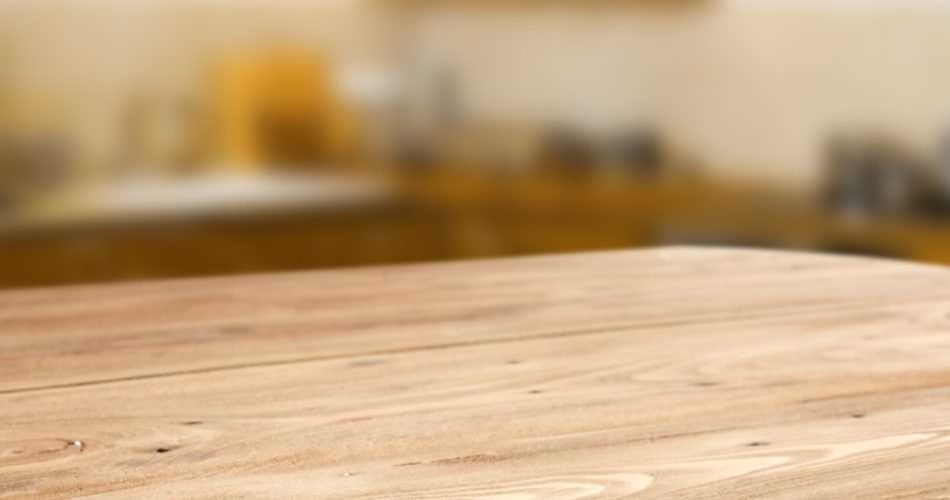
Wood is porous and can absorb liquids, which can lead to stains and damage. To prevent this, make sure to wipe up spills as soon as they occur. Use a clean, damp cloth or sponge to gently blot the spill. Avoid rubbing, as this can push the liquid further into the wood.
3. Avoid Excessive Moisture
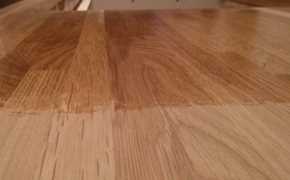
Excessive moisture can cause the wood to warp or swell. When cleaning your wooden worktops, make sure to wring out your cloth or sponge well to remove excess water. Also, avoid using steam cleaners or soaking the worktops in water.
4. Use Cutting Boards and Trivets
To prevent scratches and heat damage, always use cutting boards and trivets on your wooden worktops. Avoid placing hot pots, pans, or baking trays directly on the surface. This will help maintain the beauty and integrity of the wood.
5. Regularly Oil and Maintain the Worktops
Wooden worktops need to be regularly oiled to keep them moisturized and protected. Use a food-safe mineral oil or a specialized wood conditioner recommended by the manufacturer. Apply the oil following the manufacturer’s instructions to nourish the wood and maintain its natural beauty.
6. Keep the Worktops Dry and Well-Ventilated
Avoid leaving wet or damp items on your wooden worktops for extended periods. Always make sure to dry the surface thoroughly after cleaning or spills. It’s also important to keep the kitchen well-ventilated to prevent the accumulation of moisture, which can lead to mold or mildew growth.
By following these simple tips, you can keep your wooden worktops looking beautiful and prolong their lifespan. Regular maintenance and gentle cleaning will ensure that they remain a focal point in your kitchen for years to come.
Using Gentle Cleaning Solutions
1. Mild Dish Soap Solution
Mild dish soap is a safe and effective option for cleaning wooden worktops. To create a gentle cleaning solution, mix a few drops of dish soap with warm water in a bowl or bucket.
Using a soft cloth or sponge, dip it into the soapy water and wring it out so it’s just damp. Gently wipe down the worktop surface, being careful not to leave any standing water.
Rinse the cloth or sponge thoroughly and wipe down the worktop again with clean water to remove any remaining soap residue. Dry the surface with a clean cloth to prevent any moisture from seeping into the wood.
2. Vinegar and Water Solution
If you prefer a natural cleaning solution, you can use a mixture of vinegar and water to clean your wooden worktops. Fill a spray bottle with equal parts distilled white vinegar and water.
Spray the solution onto the worktop surface and let it sit for a few minutes to break down any grime or grease. Then, using a soft cloth or sponge, gently wipe down the surface, working in the direction of the wood grain.
Rinse the cloth or sponge thoroughly and wipe down the worktop again with clean water to remove any vinegar residue. Dry the surface with a clean cloth.
3. Baking Soda Paste
If you have tough stains or dried-on food on your wooden worktops, you can make a gentle cleaning paste with baking soda and water.
In a small bowl, mix a tablespoon of baking soda with enough water to form a paste. Apply the paste to the stained areas and gently scrub with a soft cloth or sponge.
Rinse the cloth or sponge thoroughly and wipe down the worktop again with clean water to remove any baking soda residue. Dry the surface with a clean cloth.
4. Commercial Wood Cleaner
If you prefer to use a commercial wood cleaner, make sure to choose one specifically designed for wooden surfaces. Follow the instructions on the product label for the correct usage and dilution ratio.
Apply the wood cleaner to a soft cloth or sponge and gently wipe down the worktop surface. Rinse the cloth or sponge thoroughly and wipe down the surface again with clean water to remove any cleaner residue. Dry the surface with a clean cloth.
- Mild dish soap is a gentle option for everyday cleaning of wooden worktops.
- A vinegar and water solution can be used for natural cleaning.
- A baking soda paste can help remove tough stains or dried-on food.
- If using a commercial wood cleaner, follow the product instructions.
Avoiding Harsh Abrasives
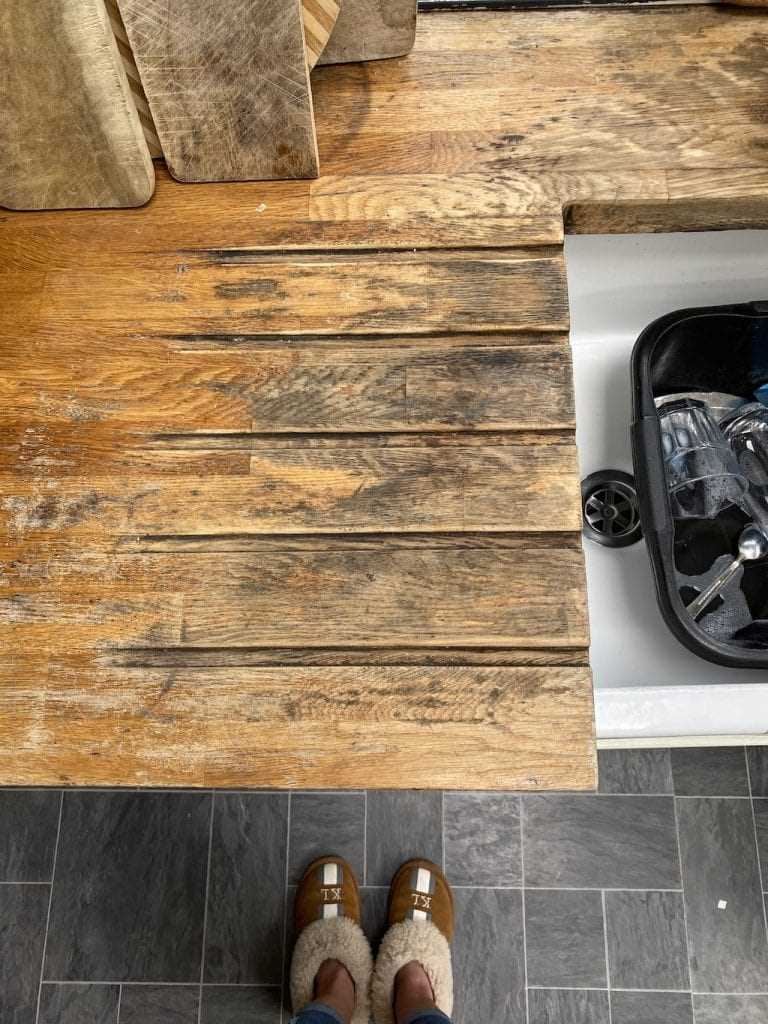
When cleaning your wooden worktops, it is important to avoid using harsh abrasives that can damage the surface. Abrasive materials can scratch the wood and strip away the protective finish, leaving it vulnerable to stains and moisture.
Instead, opt for gentle cleaning solutions and methods that will effectively remove dirt and grime without causing harm. Here are some tips to help you avoid using harsh abrasives:
1. Use mild soap and warm water
Start by mixing a small amount of mild soap with warm water. Soak a soft cloth or sponge in the soapy water and wring out any excess moisture. Gently wipe down the wooden worktops using circular motions, being careful not to apply too much pressure. Rinse the cloth or sponge frequently to remove any dirt or soap residue.
2. Vinegar and water solution
If you prefer a natural cleaning solution, you can mix equal parts vinegar and water. Vinegar has natural antibacterial properties and can help remove stains and odors from the wood. Apply the vinegar and water solution to a soft cloth or sponge and wipe down the worktops as described above. Rinse the cloth or sponge frequently.
3. Baking soda paste
For more stubborn stains or grease, you can make a paste using baking soda and water. Apply the paste to the affected area and gently scrub using a soft cloth or sponge. Rinse the cloth or sponge frequently and continue scrubbing until the stain or grease is removed. Be careful not to scrub too hard to avoid damaging the wood.
4. Avoid abrasive sponges or brushes
When cleaning wooden worktops, it is best to avoid using abrasive sponges or brushes. These can scratch the wood and leave visible marks. Instead, opt for soft cloths or non-abrasive sponges that will gently remove dirt and grime without causing damage.
5. Regularly oil and seal the wood
To maintain the beauty and durability of your wooden worktops, it is important to regularly oil and seal the wood. This helps to replenish the natural oils, protect against stains and moisture, and enhance the natural grain of the wood. Follow the manufacturer’s instructions for the specific oil or sealant you are using, and reapply as needed.
By avoiding harsh abrasives and using gentle cleaning methods, you can keep your wooden worktops looking clean and beautiful for years to come.
Regular Maintenance and Preventive Measures
Clean spills immediately
One of the most important preventive measures for wooden worktops is to clean up spills immediately. Liquids such as water, oil, and vinegar can seep into the wooden surface and cause stains or damage over time. Use a clean cloth or paper towel to blot the spill and then clean the area with a mild soap and water solution.
Avoid cutting directly on the surface
While wooden worktops are durable, cutting directly on the surface can lead to scratches and cuts. Always use a cutting board or mat to protect the wood. This will help to preserve the appearance and integrity of the worktop.
Use trivets or heat pads
Hot items such as pots and pans can cause damage to wooden worktops. Protect the surface by using trivets or heat pads under hot cookware. This will prevent heat marks and burns, keeping your worktop in good condition.
Use coasters and placemats
Prevent water rings and stains by using coasters and placemats under glasses, cups, and plates. This simple act will help to protect the wooden worktop from moisture and potential damage.
Regularly oil the worktop
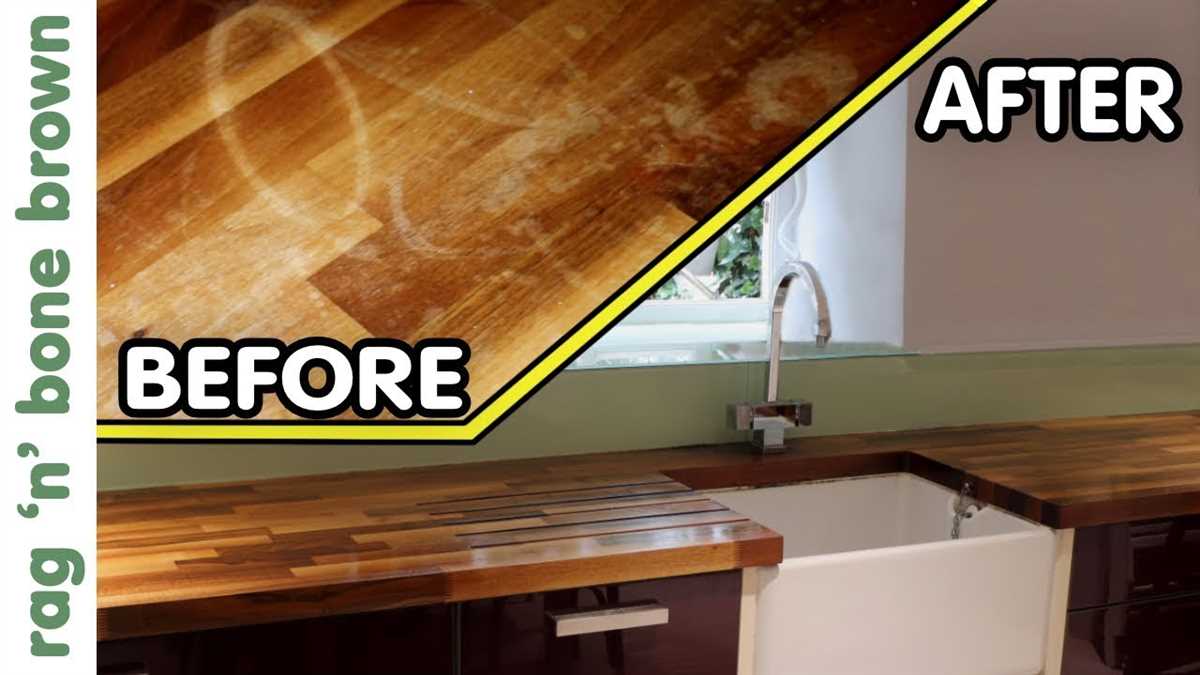
Wooden worktops should be regularly oiled to keep them looking their best and to protect the surface. Apply a food-grade mineral oil or a specialized worktop oil every few months. Follow the manufacturer’s instructions for application and drying times.
Avoid harsh chemicals
When cleaning your wooden worktop, avoid using harsh chemicals or strong solvents, as they can damage the wood’s surface and finish. Stick to mild soap and water solutions or specialized wood cleaners.
Wipe up excess moisture
After cleaning or any contact with water, make sure to wipe up excess moisture from your worktop. Prolonged exposure to moisture can cause warping or swelling, leading to potential damage. Use a dry cloth or towel to ensure the surface is completely dry.
Regularly inspect for damage
As part of your regular maintenance routine, inspect your wooden worktop for any signs of damage, such as cracks, scratches, or discoloration. Address these issues promptly to prevent further damage and maintain the quality and appearance of your worktop.
Use protective pads under appliances
If you have appliances such as blenders or mixers on your wooden worktop, use protective pads or mats under them. This will prevent any vibrations or movement from damaging the surface of the worktop.
Avoid direct sunlight
Direct sunlight can cause the wood to fade or warp over time. If possible, avoid placing your wooden worktop in direct sunlight or use curtains or blinds to reduce its exposure to sunlight.
| Preventive Measures | |
|---|---|
| Clean spills immediately | Wipe spills immediately to prevent stains and damage. |
| Avoid cutting directly on the surface | Use a cutting board or mat to protect the wood. |
| Use trivets or heat pads | Protect the surface from hot cookware. |
| Use coasters and placemats | Prevent water rings and stains. |
| Regularly oil the worktop | Keep the worktop looking its best and protect the surface. |
| Avoid harsh chemicals | Stick to mild soap and water solutions or specialized wood cleaners. |
| Wipe up excess moisture | Ensure the surface is completely dry after cleaning. |
| Regularly inspect for damage | Address any signs of damage promptly. |
| Use protective pads under appliances | Prevent damage from vibrations or movement. |
| Avoid direct sunlight | Reduce exposure to sunlight to prevent fading or warping. |
Special Care for Stubborn Stains
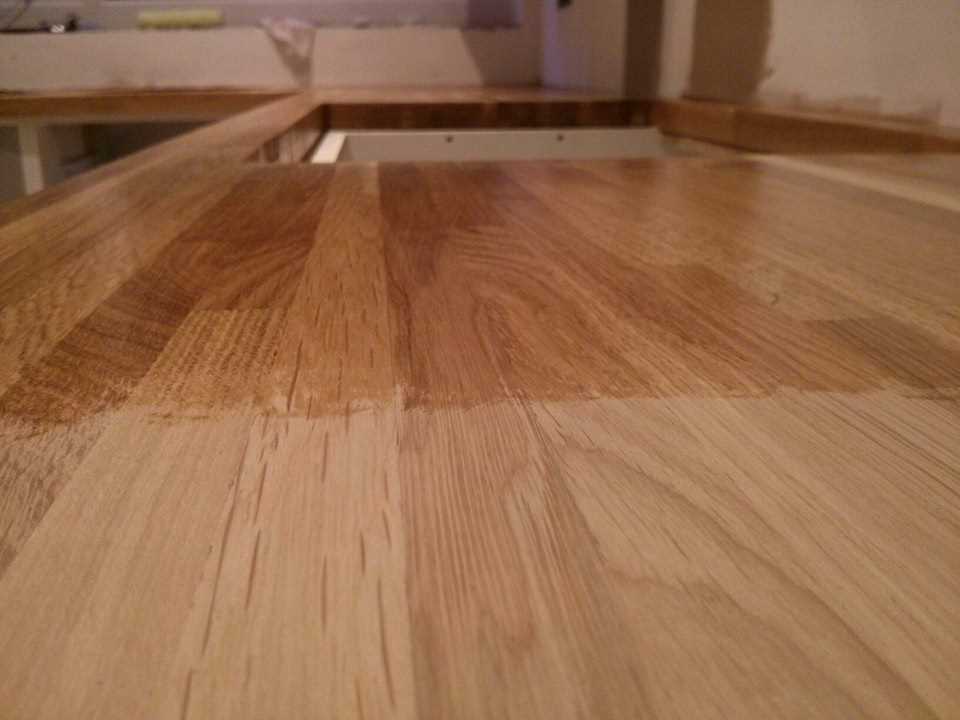
Wooden worktops can sometimes develop stubborn stains that require special care to remove. Below are some tips and methods to tackle these tough stains:
1. Oil-based Stains
If you have oil-based stains on your wooden worktop, such as grease or cooking oil, follow these steps to remove them:
- Apply a small amount of dish soap or mild detergent to the stained area.
- Scrub the area gently with a soft-bristle brush or sponge.
- Rinse the area with warm water and dry it thoroughly.
- If the stain persists, create a paste using baking soda and water and apply it to the stain. Let it sit for a few minutes before scrubbing and rinsing.
2. Water Stains
If your wooden worktop has water stains, there are a few methods you can try to remove them:
- Apply mayonnaise or petroleum jelly to the stained area and let it sit overnight. Wipe it off the next day.
- Make a paste using equal parts baking soda and water. Apply the paste to the stain and gently rub it in a circular motion. Rinse and dry thoroughly.
- If the stain is still visible, lightly sand the area with fine-grit sandpaper and then reapply a protective finish.
3. Wine or Coffee Stains
For wine or coffee stains on your wooden worktop, try the following methods:
- Blot the stain with a clean cloth or paper towel to remove as much of the liquid as possible.
- Mix equal parts vinegar and water, and dab the mixture onto the stain. Let it sit for a few minutes before wiping it off.
- If the stain remains, create a paste with baking soda and water. Apply it to the stain and gently scrub with a soft brush. Rinse and dry thoroughly.
Remember, it’s important to test any cleaning solution or method on a small, inconspicuous area of your wooden worktop before applying it to the entire surface. This will ensure that it doesn’t cause any damage or discoloration.
Finishing and Refinishing for Longevity
Proper finishing and refinishing techniques are essential to ensure the longevity of your wooden worktops. By following these guidelines, you can maintain the beauty and functionality of your worktops for years to come.
Regular Cleaning
To keep your wooden worktops in good condition, it is important to clean them regularly. Use a damp cloth or sponge to wipe off any spills or stains immediately. Avoid using harsh chemical cleaners, as they can damage the wood. Instead, use a mild soap or a wood-specific cleaner. Dry the worktops thoroughly after cleaning to prevent water damage.
Protective Coating
Applying a protective coating to your wooden worktops can help prevent staining, scratching, and moisture damage. There are various options available, such as oil, wax, varnish, or lacquer. Choose a coating that is specifically designed for wooden surfaces and follow the manufacturer’s instructions for application. Regularly reapply the coating to maintain its effectiveness.
Refinishing
Over time, wooden worktops may become worn or damaged. Refinishing can help restore their beauty and durability. Begin by sanding the surface to remove any existing finishes, stains, or imperfections. Use a coarser grit sandpaper to start and gradually switch to a finer grit for a smooth and even finish. After sanding, wipe away any dust with a damp cloth and allow the worktops to dry completely. Apply a new protective coating to seal and protect the wood.
Preventative Measures
To extend the longevity of your wooden worktops, take preventative measures to avoid damage. Use cutting boards or chopping blocks to protect the surface from knife marks. Place trivets or heat-resistant pads under hot pots and pans to prevent heat damage. Avoid placing heavy objects directly on the worktops to prevent dents or scratches. Regularly inspect your worktops for any signs of wear and address them promptly to prevent further damage.
Conclusion
By following these finishing and refinishing techniques, you can ensure that your wooden worktops remain beautiful and functional for many years. Regular cleaning, applying a protective coating, refinishing when necessary, and taking preventative measures will help maintain the longevity of your worktops.
FAQ
Can I use vinegar to clean my wooden worktop?
While vinegar is a natural cleaning agent, it is not recommended for use on wooden worktops. Vinegar is acidic and can potentially damage the wood’s finish or cause it to dry out. It’s best to stick to mild soap or dishwashing liquid mixed with warm water for cleaning wooden worktops.
How often should I apply oil or wax to my wooden worktop?
The frequency of oiling or waxing your wooden worktop depends on its usage and the type of wood. As a general guideline, it’s recommended to apply a protective oil or wax every three to six months to keep the wood moisturized and protected. However, if you notice the wood starting to look dry or lose its sheen, it may be time to apply another coat.
Can I place hot pans or dishes directly on my wooden worktop?
It is not recommended to place hot pans or dishes directly on a wooden worktop, as the heat can potentially damage the wood’s finish or cause it to warp. It’s best to use trivets or heat-resistant mats to protect the surface from heat damage.












